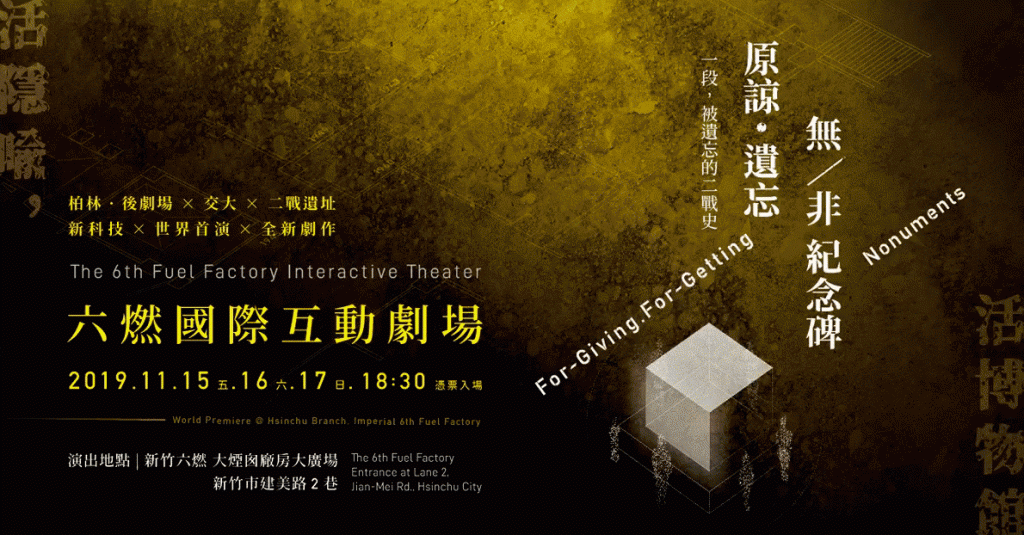賴雯淑 Wen-Shu Lai
教授 / 計畫總主持人 / 製作人
Professor, Chief Project Director, Producer
Collaborative theater production & performances by transArt NCTU & post theater
活隱喻.活博物館 — 六燃國際互動劇場
交大跨領域藝術團隊與德國後劇場聯手製作
國立交通大學和德國柏林後劇場(post theater)聯合製作的六燃國際互動劇場,將於「原日本海軍第六燃料廠 新竹支廠」的大廣場舉行世界首演,此次推出的兩劇《原諒.遺忘》(For-giving, For-getting)和《無/非 紀念碑》(Nonuments),是新竹生博物館(Hsinchu Living Museum)的重要內容之一,以深厚的人文省思出發,以智慧科技融合劇場表演來進行對人的關懷,對歷史的探究,更是在新竹進行深化紮根,與國際社會對話的行動!
劇場演繹曾在六燃發生的生命故事,除了是向與「原日本海軍第六燃料廠 」所有相關的人事物致意外,也折射出這段關於台灣的殖民二戰史。將forgiving, forgetting轉化為 for-giving, for-getting,帶出「原諒是為了給予;遺忘是來自拿取」的潛意涵;《無/非 紀念碑》(nonuments)源自monument紀念碑一字,但後劇場藝術總監Max Schumacher 將m刪除,以n來取而代之,使其成為特殊名詞—— nonuments 無/非 紀念碑,它是指涉「無」紀念碑,或「非」紀念碑,否定了紀念碑是為了長遠未來或世代相傳」的概念。
透過跨域藝術、IoTtalk物聯網科技、互動劇場的異域結盟,投入再造歷史現場的實踐行動,也同時展開跨國、跨領域的時空對話。 六燃劇場具有以下七項特色:
- 在台灣二戰六燃特定場域演出
- 在新竹進行世界首演
- 台灣與德國柏林聯手的國際製作
- 互動媒體加上全新科技
- 50位國際藝術家的參與
- 全新音樂、影像與文本
- 採用智慧手機結合 IoTtalk與 AiPOLLING 投票系統,邀請現場觀眾以集體參與的方式共創二戰紀念碑、共構台灣二戰史。
六燃計劃主持人賴雯淑教授提出:「現場觀眾一起使用IoTtalk科技建置數位紀念碑,是否跨越了科技藝術的範疇,進入了誰可以豎立紀念碑?誰擁有話語權的議題思辨?」這段話同時指出「平民」在歷史書寫上不可或缺的位置。台、徳創作團隊非常期待這次的劇場演出,能引領觀眾進入新竹六燃這個活隱喻的空間,一起啟動另類的歷史書寫,在展開遺忘、記憶、原諒的各種對話中,再造我們的歷史現場,建構活博物館,共同展望台灣希望的未來。

《原諒.遺忘》
(中文全紀錄片)
“For-giving.For-getting ”
(English Full 1080p Documentary)
導演 | 王小苗、黃法宓
製作人 & 藝術總監 |賴雯淑
編劇 | 王小苗
《無/非 紀念碑》
(中文全紀錄片)
“Nonuments ”
(English Full 1080p Documentary)
藝術總監 & 導演 | Max Schumacher
製作人 | 賴雯淑
編劇 |Max Schumacher & Hiroko Tanahashi
合作單位|post theater & IoT talk NCTU & transArt NCTU
For-giving.For-getting ─
原諒是為了給予.遺忘是來自拿取
《原諒.遺忘》和《無/非 紀念碑》展演的目的是希冀引起國內與國際公眾的注意,並提高他們對台灣新竹前日本海軍第六燃料廠的歷史意義和重要性的認識。從另一個意義上說,歷史是一個活的、不斷發展演繹的過程,而且始終處於現在式。《原諒.遺忘》和《無/非 紀念碑》多媒體藝術展演是為了推動新竹六燃二戰遺址成為「新竹生博物館」而舉行的台德藝術家聯合展演活動。
“For-giving.For-getting” and “Nonuments” are two Taiwan-German collaborative performances dedicated to raising public awareness domestically and internationally about the historical significance of the former Imperial Japanese Navy’s Sixth Fuel Factory, a WWII historical and cultural heritage site in Hsinchu, Taiwan. This performance series is intended to empower the audience to discuss and interpret the past, the present, and the future of this historic site, expecting to extend and enrich WWII history through alternative perspectives and live performances. We believe that the artists and participants will add an extra dimension to the multifold histories and memories of WWII. History, in another sense, is a living, evolving process that always unfolds in the present tense. As a result, the prime objective of For-giving.For-getting.nonuments is to accelerate the transformation of the historic site of the Imperial Japanese Navy’s Sixth Fuel Factory into the “Hsinchu Living Museum”.
Semantic lacuna — 語意的空缺
運用「語意的空缺」將之應用在亦覺藝術表演上。新意和新視覺是透過創造字或改變字詞而獲得。例如:原諒是為了給予 .遺忘是來自拿取.無 / 非 紀念碑
The collaborative performance series comprises two side-by-side pieces: For-giving.For-getting and nonuments. In these two pieces, we interpret and present the meanings of forgiving, forgetting and non-nonument within the context of the former Imperial Japanese Navy’s Sixth Fuel Factory in Hsinchu, Taiwan.
Applying “semantic lacuna” to our multimedia performance, projection and dance, deriving new meanings and visuals from the terms of For-giving.For-getting and nonuments
透過一個字詞中字母順序的重新排列、文字的拆解或分割,把相關或不相關的字放置在一起,不但具有隱喻的效果,還產生意義的轉折,傳達出複雜交錯的弦外之音。這是我們這次展覽所使用的文字遊戲。我們「轉換」文字,尋找前後兩者之間的「空隙」與意義的轉折,藉以獲取展演作品的情節靈感。以下是我們所採用的文字轉換,以造成意義延伸或轉折(Kentridge,2003; Lipman, 1994):
Changing the letter sequence in a word or dividing it into sections, we juxtapose related or unrelated words to invoke metaphors, changes in meaning, and undertones that convey mixed messages. This is the word game we apply to our performance. We try to identify the “gap” between the juxtaposed words, from which we draw inspirations for the plots of our performance. Such change or extension in meaning caused by substituting an alien term for the absent term (Kentridge 2003; Lipman 1994) is exemplified as follows:
Amnesia→Amnesty
Amnesia→Amnesty
Historical→Hysterical (The dancers are expected to express this sentiment.)
Disremember→dis-remember (not to be a member again)
Forgiving→for-giving→for giving
Forgetting→for-getting→for getting
Monuments→nonuments (non-monument)
Amnesia 失憶症→ Amnesty 大赦免
Historical 歷史的→ Hysterical 歇斯底里的 (希望舞者要表達出這一部分)
Disremember→dis-remember (not to be a member again)
Forgiving 原諒→ for-giving → for giving為了給予
Forgetting 忘記→for-getting→for getting 為了拿取
Monuments 紀念碑→nonuments (non monument)無/非 紀念碑
文字的轉換具有使用隱喻的作用,也帶來不同的意義或歧義性。我們的作品意圖強調「歷史」、 「記憶」、「原諒」、「忘記」與「失憶」之間無法切割的關係。
The change and transformation of words has a metaphorical effect. They are called “living metaphors” on account of the fact that they lead to different meanings or ambiguity. Our job is to illuminate the indissoluble bonds among “history,” “memory,” “forgiving,” “forgetting” and “amnesia.”
對施暴者的赦免(amnesty) ,就如同得了歷史的(historical)失憶症(amnesia)一般,後果將會是歇斯底里 (hysterical)跟難以預料的。暗示「記憶的恢復」和「歷史的還原」是一體兩面,目的不在復仇,而在療傷。Remember 是 re-member, 可以解釋為「重新成為其中一份子( be a member again)」之意,指的是事件中的「施暴者」與「受害者」其實是互為主客體的,雙方在記起與療癒後,都可以重新成為世界的一份子。
Granting an amnesty to a perpetrator is tantamount to suffering historical amnesia. Its consequence will be as hysterical as unpredictable. It implies that the “recovering of memory” and the “restoration of history” are two sides of the same coin. Their purpose is not so much to avenge as to heal. “Remember” is juxtaposed with “re-member,” which can be interpreted as “being a member again.” On a more specific basis, a perpetrator and a victim are intersubjective entities that represent two opposite poles. Both can become members of the world again after recovering the forgotten memory and healing the wound of history.
Forgiving 是 for-giving,可詮釋為:「原諒」其實是「給予(for giving)」;forgetting 是 for-getting, 可詮釋為:「忘記」的目的在於「拿取(for getting )」 (Neale Donald Walsch,1996/2005);disremember 是 dis-remember, 可詮釋為:「遺忘」 的行為會使自己「不再是其中的一份子(not to be a member again)」。
“Forgiving” is juxtaposed with “for-giving,” a term that could be interpreted as “for giving,” and “forgetting” with “for-getting,” which could be interpreted as “for getting” (Walsch 1996/2005). “Disremember” is juxtaposed with “dis-remember,” a term that could be interpreted as “not to be a member again.”
因此,參與展演的藝術家正是為從語意的空隙而生出的新意義、新影像而奮力演出。後劇場post theatre 使用‘nonuments’—紀念碑,非紀念碑; 交大跨領域藝術團隊transArt NCTU使用“For-getting,For-giving”作為新竹燃料廠二戰歷史遺址的合作表演作品的標題。 如果一座紀念碑是戰爭悲劇的結束,那麼「非—紀念碑」就是一個辯論的開場。 如果「獲取」是一場戰爭悲劇的未閉合的傷口,那麼「給予」就是解藥。
The artists in this performance are exactly striving for creating new meanings and images from the semantic lacuna. The post theater and the transArt NCTU team respectively titled their collaborative performances for this historic site as nonuments (nonument, non-monument) and For-getting.For-giving. If a onument symbolizes the curtain-fall of a war tragedy, a mnonument represents the onset of debates. If “for-getting” is a war-inflicted wound, “for-giving” might be a cure.
對於這次來自德國和台灣的藝術家們而言,“nonuments”、“For-getting,For-giving”,指向了這座位在台灣新竹的日本海軍第六燃料廠歷史遺址的「活的博物館」的「活隱喻」,從這3個隱喻的語義空白中所產生的新意義和新影像將是這次他們展演的核心和主題。
The German and Taiwanese artists use the three living metaphors of nonuments, For-getting, and For-giving to represent the living museum on the historic site of former Imperial Japanese Navy’s Sixth Fuel Factory in Hsinchu, Taiwan, and their performances revolve mainly around the new meanings and images generated from the semantic lacuna in these three metaphors.
